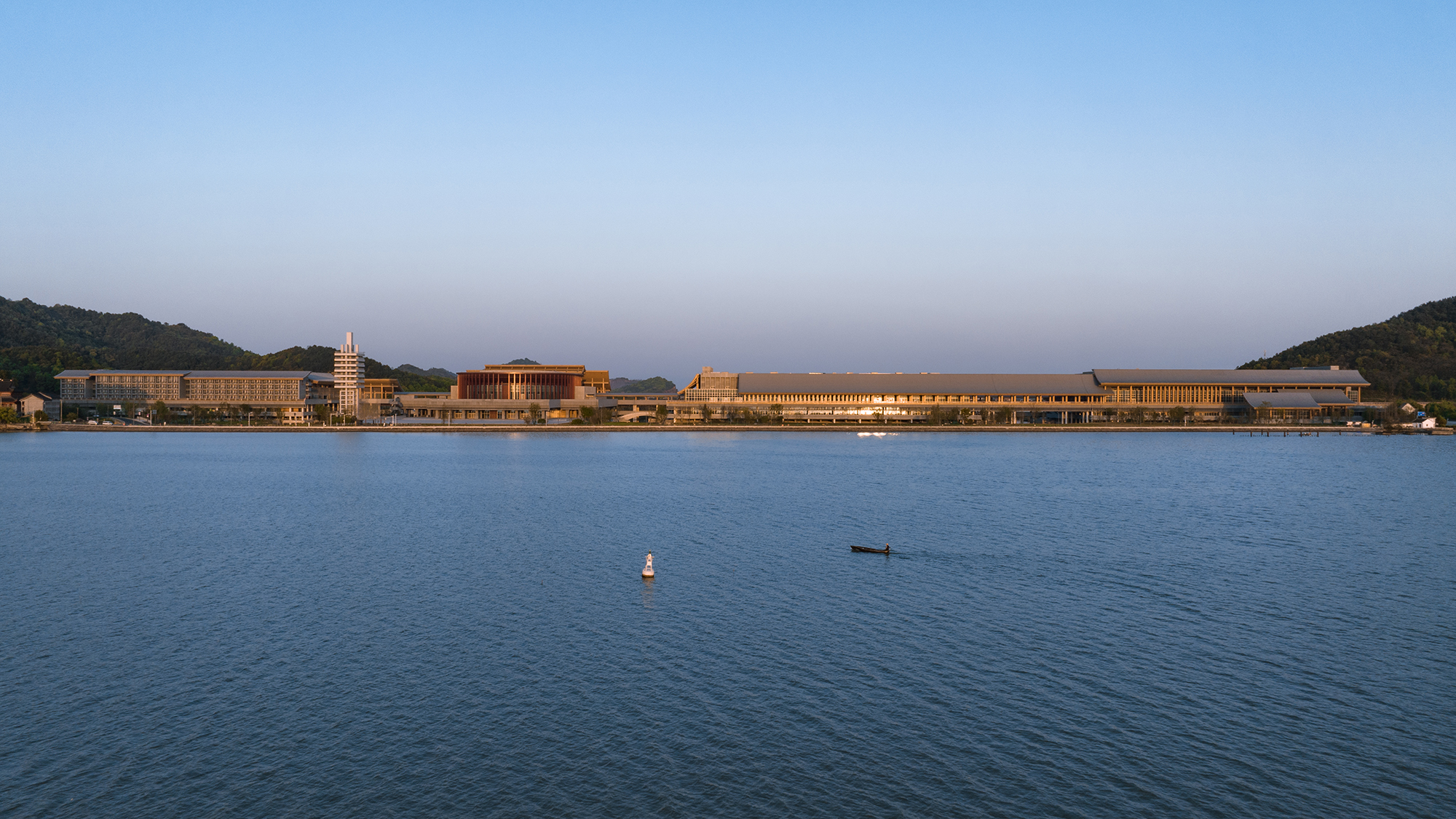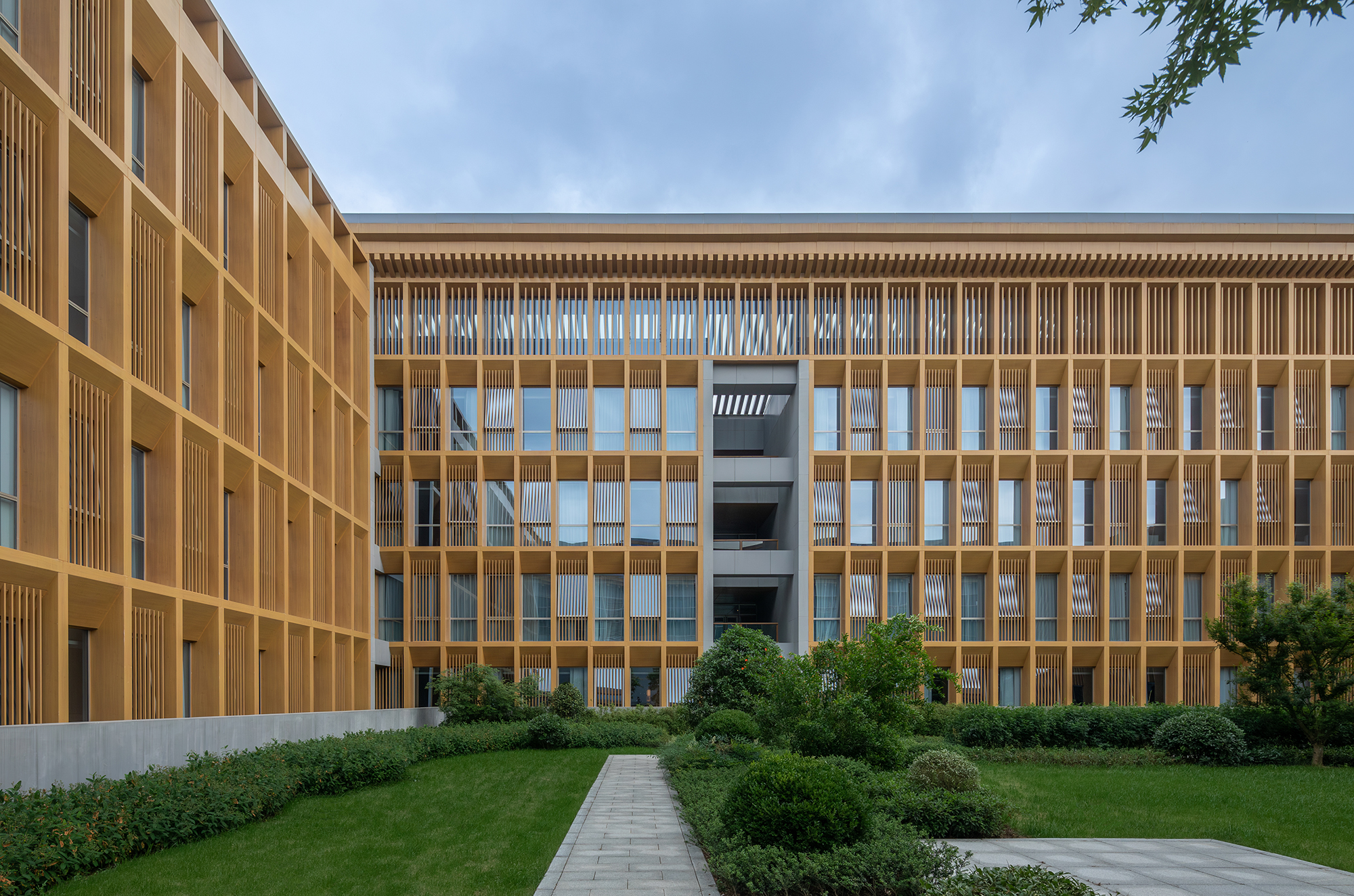

方案设计 深圳汤桦建筑设计事务所有限公司
EPC工程总承包 北京市建筑设计研究院有限公司、中国建筑第八工程局有限公司
项目地点 浙江宁波
建成时间 2022年
建筑面积 398, 413平方米
本文文字由汤桦建筑设计提供。
“具有国际一流水准,富有中国江南韵味”—— 一座绿水青山之间的廊桥会议中心应运而生。带有极其鲜明的在地性及唯一性的设计,从全球范围内的竞赛中脱颖而出并顺利落成,并作为“一带一路”和“长三角一体化”政务与商务活动的空间载体及民族文化象征,成为连接宁波与世界的桥梁。
Tanghua Architects has conceived a conference center in the form of a covered bridge surrounded by picturesque mountain and river landscapes. The scheme, with distinctive design and a response to the genius loci, stood out among other proposals in an international competition and has been successfully executed. The conference center serves as a venue for government affairs and business activities related to the "Belt and Road Initiative" and "Yangtze River Delta Integration Plan". Furthermore, it symbolizes national culture and plays the role of a bridge connecting Ningbo and the world.




会议中心选址位于宁波市区东钱湖风景名胜区,紧邻东钱湖南湖西岸,北至奕大山,南至东坑山。核心地块用地面积约49公顷(735亩),溪水、河流、湖泊、山涧、荷塘、水口、江岸在这里汇聚,千亩稻田、湿地汇水而生。
The conference center is located in the Dongqian Lake Scenic Area on the southeast outskirts of Ningbo City. Adjacent to the west shore of Dongqian Lake and connected to two mountains on its north and south sides, the core plot spans about 49 hectares (735 mu). It's where the streams, rivers, lakes, mountains, lotus ponds, water outlets and riverbanks meet, and expansive paddies and wetlands unfold across thousands of square meters.


▲ 项目视频 摄影:极客视觉 | 谢振国;©汤桦建筑设计
我们完整保留了场地现状地貌、水系和生态系统,会议中心建筑群集约架空布置在一条南北走向的带形区域内,南北总长一公里,东西进深一百米。建筑的集约放置,让550亩农业景观得以保留——这是城市快速扩张时代中对农业景观样本的浪漫挽留,一方面直面建筑密度和产业发展的关系,为城市发展的土地诉求预留了弹性;另一方面完整保留的农田成为生态连续的、具有雨洪韧性的“城田共生”过渡地带。
We have preserved the site's existing topography, water system and ecosystem, with the conference center arranged overhead in a north-south belt-shaped area. The compact configuration of the building ensures the preservation of 36.7 hectares of agrarian landscape, embodying a romantic retention of agricultural landscape in the era of rapid urban expansion. On one hand, this allows for flexibly reserves land for potential future urban development; On the one hand, the existing farmland has become an ecologically continuous transition zone that facilitates "city-field symbiosis".




廊桥被场地现状中的三个水口划分为四个区域,由北至南的城市公共性逐步减弱。最北段布局11000平方米大型多功能厅,依次往南为5500平方米主会场及3700平方米宴会厅、1800平方米首脑会议厅,最南端为342间客房的五星级酒店。
The covered bridge is divided into four areas by three water outlets with the programs arranged according to the public-private logic from north to south. The northern part of the layout is an 11,000㎡ large-scale multi-purpose hall, which is followed by the 5,500㎡ main venue, the 3,700㎡banquet hall and the 1,800㎡summit area. The southern part is a five-star hotel with 342 rooms.









三个水口区域,形成会议功能体量之间的景观节点及视廊开放空间。沿水布局小尺度的街道与商业聚落,流线与会议中心的廊院结合,展陈一切归纳于街巷间的日常——有村落、有街市、有庙堂……我们希望建立一个多维度的江南水乡诗意长卷。
The three water outlets naturally become landscape nodes between the functional volumes and open spaces. Small-scale streets and commercial settlements which are connected to the conference center are arranged along the water, together with the villages, market streets, temples, they constitute a multi-dimensional urban scene like that of a picturesque Jiangnan scroll painting.




建筑整体架空5米,并设5米厚度的结构设备层和服务层,会议层地面距离场地现有地面10米。我们利用南北山地高差,实现多层楼面平接城市道路,立体化组织交通。
The main building volume is elevated to 5m in height, with the main structure, equipment and service functions packed into a 5m height volume. The conference floor is 10 meters above the site's ground. Taking advantage of the site's height variance between the north and the south, the conference center can be connected to the city road on different heights, realizing three-dimensional traffic.
会议期间参会人员采用上进下出的交通方式,会议服务流线及货运流线独立组织,避免流线交叉。多个出口均连接城市公共交通网络,解决大型会议的瞬时集散问题。
When hosting meetings, attendees enter the conference center from the upper level and exit from the lower level, while service circulation and freight circulation are organized separately. With multiple exits connecting with the urban public transportation network, smooth assemblage and evacuation are ensured.

在会议场馆闭馆的平日,廊桥与商业街连成一体,廊下空间对市民24小时开放,成为极具江南水乡标志的“市集”与聚落。
When the conference venues are closed, the covered bridge and the commercial streets are open to the public round the clock, transforming into an iconic market and settlements reminiscent of Jiangnan water towns.

廊桥并不是一座通常意义的桥,而是一座桥形的建筑,是一个多功能的公共开放空间,具有遮阳避雨、供人休憩、交流、聚会、观景等作用,并为市民建立了一组独特的本地人文、历史、科学教育基地。
The covered bridge is not just a simple bridge, but rather, a building in the form of a bridge. It serves as a multi-functional public open space, providing shelter from the sun and rain, as well as a place for people to rest, communicate, gather, and enjoy the scenery. This unique structure also contributes to establishing an educational hub that blends the elements of local culture, history, and science.


绿色环保与节能减排从每栋建筑开始,扩展到城市与基础设施网络。项目基地临近高秋堰塘,是重要的泄洪滞洪区域,更是东钱湖防洪防汛系统中重要的一环。面对洪水,堵不如疏,建筑设计以干栏式建筑的方式,以廊桥式建筑的形态,架空于田野之上,连接青山、近观钱湖,不改变高秋堰本来的水文特性,不增加防洪泄洪的压力,将建筑对基地本底水文环境的干扰减少到最低。
The emphasis on environmental conservation, energy efficiency, and emissions reduction is integrated into individual buildings and the urban infrastructure network. The project site is located next to Gaoqiu Weir, an important area for flood diversion and storage as part of the Dongqian Lake flood control system. To minimize the impact on the local hydrological environment, the design team conceived a stilted bridge-style building elevated above the fields. This allows for a close view of Dongqian Lake without altering the intrinsic properties of Gaoqiu Weir.
此外,我们通过对绿化屋顶的综合利用,减少雨水径流和水污染;可渗透铺路材料的使用,保留大面积实土绿地,增加渗透和含水层回补;使用光伏与太阳能热水,提供现场再生能源;设置在场地里的地热交换系统,加大能源节约力度,节省空间资源。
To reduce rainwater runoff and water pollution, green roofs are employed, while permeable paving materials are used to retain large areas of green space and increase water infiltration and replenishment. Additionally, on-site renewable PV energy is used to provide hot water, and a geothermal heat exchange system is implemented to enhance energy conservation and save space resources.



回望渊远的河姆渡文明,耜耕稻作为其根本所在。宁波国际会议中心以湿地为本底,尽量留白场地,将高密度、高节奏的城市化区域与田园牧歌式自然空间并置,将文旅产业体系与会展产业体系相融合。项目希望建立地域文脉与现代都市的连接点,建构河湖交汇、农商皆宜的当代江南水乡,成为人民所向往的美好生活的宁波样本。
Tracing back to the cultural origin of Ningbo City, agriculture can be regarded as the root of the Hemudu culture. By preserving the natural wetland on the site, our design juxtaposes the high-density, fast-paced urbanized area with the idyllic natural space, and integrates the cultural tourism industry system with the exhibition industry system. It's the nexus between the regional culture and the modern city, a contemporary Jiangnan water town where the rivers and lakes meet and accommodate both farming and commerce, and a Ningbo sample of the people's longing for a better life.

完整项目信息
项目名称:宁波国际会议中心
项目地点:浙江省宁波市东钱湖西岸
用地面积:489, 333平方米
建筑面积:398, 413平方米
项目业主:宁波国际会议中心发展有限公司
方案设计:深圳汤桦建筑设计事务所有限公司
EPC工程总承包:北京市建筑设计研究院有限公司、中国建筑第八工程局有限公司
汤桦建筑 设计团队
主持建筑师:汤桦
项目负责人:邓芳
项目组:彭舰、张秋龙、陈文锋、汤孟禅、于文博、黄真吉、易熙豪、王鲲、刘华伟、汪田浩、刘滢、郑昕、王心足
合作公司
BIAD设计团队
总负责人:谢欣、禚伟杰、彭琳、周俊仙
项目经理:刘越
建筑设计:杨姗、滕俊、乔一兵、郭晓晨、抗莉君、孙尚文、赵岩灏、赵大伟、金依润、李舒静、刘琛、魏成蹊、蒋辰希
结构设计:卫东、韩巍、郝彤、吴珀江、程翰文、李芊、常婷、王盛、方启霄、苏伏龙、宋子魁、钮亚楠、陈雅昕、李学超、郝振宇、潘宇晨、滕飞
设备设计:徐竑雷、杨帆、王金彪、齐瑞颖、高琛、胡桂霞、徐以恒、赵欣、赵升泉、姜航、陈慧玲、黄孟娇、孙倩、龚英乾
电气设计:任红、华建江、韦洁、王凌宇、支晶晶、魏恒杰、阮家琪、赵聪、耿奕、蒋鹿岩
室内设计:北京建院装饰工程设计有限公司
室内专项负责人:王盟
室内方案:王盟、高潘、刘亚美、刘页萌、祖浩然、杜淑丽、梁学灵、屈明扬
会议深化:董兵、杨天伦、刘剑、李荣辉、陶朋伟、赵佳、黎意、李庆选、张奇
酒店深化 :赵成、李明慧、艾森、赵晶、董桐浪
室内二次机电:王森,宋俊锋、顾垚、王涛
室内软装:谭晓明、郑春梅、赵倩、王澜、李玥、田京玉、陶沛、陈昂、王琼
室内物料:李朋、刘海东
景观设计:杭州园林设计院股份有限公司
泛光照明设计:凯森数字科技有限公司
幕墙设计:同创金泰建筑技术(北京)有限公司
BIM设计:宁波优辰建筑设计咨询有限公司
人防设计:南京地下工程建筑设计院有限公司宁波高新分公司
市政设计:宁波经济技术开发区城建设计有限公司
标识设计:杭州吉承文化艺术有限公司
节能绿建顾问:宁波华聪建筑节能科技有限公司
交通顾问:北京清华同衡规划设计研究院有限公司
特殊消防设计顾问:奥雅纳工程咨询(上海)有限公司
噪声控制顾问:北京市劳保所科技发展有限责任公司
设计咨询顾问:宁波市城建设计研究院有限公司
摄影:极客视觉|谢振国、毫厘建筑摄影
部分相片源于:宁波国际会议中心管理有限公司、北京建院装饰工程设计有限公司
版权声明:本文由深圳汤桦建筑设计事务所有限公司授权发布。欢迎转发,禁止以有方编辑版本转载。
投稿邮箱:media@archiposition.com
134****9773
1年前
回复